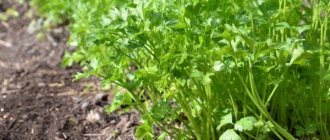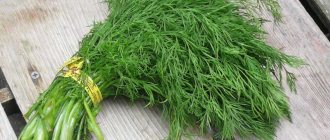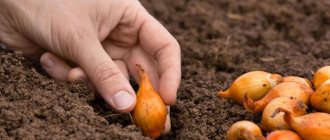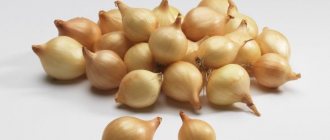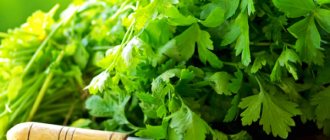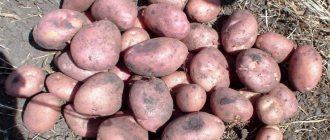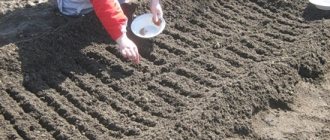Parsley and dill are widely used in cooking. They are included in salads, appetizers, marinades, first and second courses. Greens can be easily grown in your garden or summer cottage. To get an early harvest, many gardeners use the winter method of planting seeds.
This sowing option has its own characteristics, which we will discuss in the article.
Is it possible to sow parsley and dill before winter?
Parsley and dill are plant crops with high frost resistance. When sowing in autumn, the greens sprout quickly and amicably immediately after the snow melts. If seeds are sown in spring, their germination rate will be significantly lower.
This phenomenon is explained by two reasons:
- The seeds contain essential oils that delay germination and prevent the absorption of moisture necessary for germination.
- In spring, the soil may not be sufficiently moistened.
Seed material planted before winter not only tolerates frosts down to -4°C, but also receives a lot of moisture when the snow melts. A large amount of water in the soil promotes the leaching of essential oils, which ensures rapid swelling of seeds and their germination.
Advantages
More and more summer residents are switching to winter planting of greenery.
- This method has a number of advantages:
- Fresh greens appear on the table half a month earlier.
- The seeds will undergo natural stratification, which means the seedlings will be more frost-resistant.
- Overwintered seeds produce plants with good immunity, strong and hardy.
- Super-early seedlings will not be attacked by pests that have not yet emerged from winter hibernation. The cruciferous flea beetle will not be able to destroy the tender sprouts of arugula, watercress and radishes.
- This frees up time for other spring work on the site.
The best varieties for winter cultivation
Both root and leaf varieties of parsley are grown in gardens and summer cottages. The variety for planting is chosen depending on the purpose of the plant crop.
The following varieties are most often planted before winter:
- Sugar. It has a high leaf rosette and a conical root crop. Ripens early. It has excellent taste qualities of roots and leaves.
- Russian size. Refers to root species. The underground part reaches a length of 30 cm. The pulp is white with a pleasant aroma and excellent taste.
- Eagle The root variety is undemanding to growing conditions. It has lush greenery and a pronounced aroma.
- Ordinary leaf. It has a pleasant taste. It tolerates low temperatures well and germinates quickly in spring.
- Italian giant. Refers to mid-season varieties. Produces lush and fragrant greenery that grows back quickly after cutting.
- Esmeralda. The leaves of the plant have a corrugated shape. Due to their decorative appearance, they are often used to decorate a variety of dishes.
When planting dill before winter, choose zoned varieties that are suitable for a specific climate zone.
The most popular among gardeners are:
- Gribovsky. It has a spreading bush with a small rosette about 30 cm high. The leaves reach a length of 20 cm. The variety is well suited for growing in open ground. Contains a large amount of vitamins and essential oils. Positively affects digestion.
- Kibray. Refers to late-ripening and highly productive varieties. Up to 80 g of greens are collected from one bush. It has large leaves of light green color with a delicate aroma. It has excellent taste and is undemanding to care.
☝️ Aftercare
With the onset of frost, it is advisable to cover the parsley beds with fallen leaves or straw, especially in places where snow does not usually accumulate. If the winter turns out to be snowy, barriers made of old boards can be installed around the perimeter of the bed to retain snow.
In April, as soon as the first 2-3 true leaves appear, you can start weeding and thinning. These manipulations are performed very carefully so as not to harm fragile and vulnerable plantings. Larger and healthier specimens are left behind. During several thinnings, the distance between the green bushes should be approximately 10 cm.
Now they will need hydration, which is carried out several times a week. Water the parsley sprouts with water at room temperature.
In order for the plant to quickly form full-fledged leaf rosettes, it should be fed twice:
- as soon as the first leaves appear;
- during the formation of a full-fledged small rosette.
Parsley is usually fed with organic matter: mullein (1:6) or bird droppings (1:15) are bred. Of the mineral fertilizers for growing greenery, you will need nitrogen contained in ammonium nitrate, as well as potassium and phosphorus. The main thing is not to overfeed the spice, otherwise it will become tough and tasteless.
If you have problems with the germination of parsley, we recommend reading this article
The seedlings are inspected for the presence of weeds in order to remove them in a timely manner, because weeds are a source of various diseases and a refuge for the larvae of harmful insects. But sometimes parsley is still affected by the following infections:
- white spotting;
- rust;
- brown rot;
- powdery mildew, etc.
- If symptoms of disease appear : wilting, yellowness, weak growth or white coating on the leaves, it is necessary to treat all above-ground parts of the parsley with a 1% solution of Bordeaux mixture.
- If the plant is affected by powdery mildew , it will be effective to spray it with a 1% solution of colloidal sulfur.
Planting parsley in winter will produce leafy greens about a month earlier than with normal spring planting. But in order for the herb to grow luxurious and aromatic, it is necessary to comply with all of the above agrotechnical requirements.
When is the best time to plant
The timing of sowing seeds may differ for different climatic zones. Depending on the weather, greens are planted in October-early December. A necessary condition for winter sowing is stable cooling. The air temperature should be around 0°C. Select a time when the soil freezes at night and thaws during the day.
Reference! If snow is already falling, this will not be an obstacle to sowing. The snow is simply swept away from the garden bed and the seeds are planted.
When and how to plant greens?
Basil is one of the most unpretentious crops!
There is no exact date in this case, since the weather is changeable. But there are some criteria by which you can determine when it is time to sow:
1. At a temperature of 0° it is already possible to start sowing, only under the condition that no warming is expected. Usually this is mid-October - November.
2. An important criterion is freezing soil. This is necessary to ensure that the seeds do not swell and germinate ahead of time!
Features of planting in the cold season
Planting greenery before winter has its own characteristics and advantages. The harvest will be as early as possible. Plants are actively germinating, strong and strong shoots appear. They are edible immediately after the snow melts.
Attention! Early harvesting of greenery makes it possible to reuse this area.
How to choose the right place
For sowing seeds, choose open areas that warm up well in the sun and where the snow quickly melts in the spring. A good option for a garden bed is southern slopes.
You can choose a place for planting under the crown of a tree - there is no risk of shading, since greenery appears much earlier than the buds bloom.
It is not recommended to use the site in the shade of buildings and fences. When sowing parsley and dill in winter, lowlands should also be avoided.
When choosing a location, keep in mind that greenery is demanding on the composition of the soil. Plant crops love fertile, organic-rich soil with a light and loose structure. The best option for growing them is soil with neutral acidity.
Reference. Dill and parsley do not grow well in acidic soil. However, excessive liming is also not recommended, since if there is too much lime in the garden bed, the dill will change color from green to red.
It is useful to plant seeds in areas where they were previously grown:
- cabbage;
- potato;
- cucumbers;
- beets;
- carrot.
The benefits of planting greenery before winter
- Early harvest. Early, because it is really much earlier than the usual greenery, which is planted only in the spring. Many gardeners are just choosing a place for future greenery, but hay greenery is already sprouting before winter.
- Quality harvest. Indeed, all the leaves and twigs are strong, massive and well branched, creating lush bunches.
- The aroma and taste are excellent. The greens, which not only hatch in early spring, but also actively stretch, have a high vitamin content, and they also smell good, giving fresh salads a piquant note.
- Seeds planted in autumn germinate much better, as stratification makes itself felt. So, for example, dill sprouts very poorly when planted in spring, since it’s all due to the essential oils that cover each seed. It is they that interfere with rapid germination, since there is no way to fully swell, because moisture due to the oil cannot get close to the seed. As a result, autumn planting is justified in practice, because during the winter, during periods of rain and thaw, these essential oils are gradually washed away, and the dill gains moisture, which guarantees successful and abundant shoots in the spring.
Planting and growing technology
Although parsley and dill do not require care, when growing these crops it is worth taking into account the peculiarities of agricultural technology.
Seed preparation
Winter sowing of greens does not require soaking, dressing or germination of planting material.
Attention! Before winter, the seeds are placed in the ground dry.
During planting and after it, do not water the soil, since any measure aimed at stimulating seed germination can lead to the death of the plant crop.
Damaged and low-quality seeds are discarded upon inspection.
Soil preparation
The soil for parsley and dill begins to be prepared several weeks in advance. In the selected area, weeds are carefully selected, carefully removing their root system.
During digging, add compost or humus and add a small amount of mineral fertilizers. For 1 sq. m of land, it is recommended to use a composition that includes:
- ammonium nitrate (15 g);
- superphosphate (10 g);
- potassium salt (10 g).
The bed is well loosened and leveled with a rake. To prevent the germination of weeds and waterlogging of the soil, the prepared area is covered with slate, roofing felt, cardboard or pine branches.
Landing
When sowing dill and parsley, adhere to the following rules:
- Seed material is placed in furrows to a depth of 5 cm, leaving a distance between rows of 10-15 cm.
- The seeds are placed more densely, since some of the planting material may freeze during the cold period.
- To obtain a more uniform sowing, use dry river sand. It is pre-mixed with green seeds.
- Fill the furrows with a mixture of soil, peat, humus and sand. This composition not only protects well in frosts, but also promotes rapid germination of seed material in the spring.
Then the bed is covered with mulch (fallen leaves, hay, straw, pine paws).
Attention! When growing greens, it is recommended to place the rows from north to south so that they are evenly heated by the sun throughout the day.
Before winter, dill can also be sown according to a different scheme. The seeds are fanned out over the area, and a small amount of humus and mulch is scattered on top. With this method it is possible to obtain a higher yield of greens.
Features of care
When caring for greenery, the following agrotechnical measures are carried out:
- Watering. In spring, the soil is moistened as needed several times a week. Water in the evening. During the hot period, the amount of watering is increased so that the plants do not form flower stalks.
- Feeding . If in the fall, when preparing the site, the soil was enriched with mineral and organic fertilizers, the greens will not need additional feeding in the next season.
- Weeding and loosening. Regularly remove weeds and loosen the soil. This is done 1-2 times a month.
- Shelter from the heat. In hot weather, it is advisable to shade the greens so that they do not wilt. To do this, use opaque material, which is fixed on special stands.
- Pest control. To protect plants, tobacco dust, harmless to the body, is used. It is mixed with sand in equal proportions and sprinkled on the bed around the bushes.
- Treatment of diseases . The use of modern biological agents that are safe for health is shown.
What to plant before winter. What to plant in the fall in the garden
The list of plants that are planted in the garden before winter is very large. Long-term observations of scientists conducting experiments with the effects of low temperatures on garden crops suggest that seeds left in the ground in winter do not die. After harvesting summer vegetables from the beds, you need to prepare for sowing. The soil is loosened, fertilizers are added - humus, compost, peat.
Crops that can be sown in the garden before winter include:
- greens - parsley, cilantro, spinach, basil.
- vegetables - tomatoes, beets, celery, radishes, potatoes, carrots, peas, onions;
- berries – victoria, wild strawberry, strawberry.
This time is suitable to sow green manure - plants that help improve the condition of the soil. It is recommended to plant peas, beans, and mustard in those beds where onions, carrots or garlic used to grow. Rye or oats are planted in a potato field. These cereals help remove weeds. As a result, in the spring, after digging up the soil, there are much fewer harmful plants.
In October
To choose the right time for winter sowing, you need to study the weather forecast for the month ahead. Planting dry seeds should begin when the daytime temperature drops to 3-5 degrees Celsius, and at night there is 1-3 degrees below zero. The first ten days of October are suitable for planting strawberry seedlings. The bushes are planted at intervals of 15 cm in furrows that are 30-35 cm apart. In the middle of the month, winter garlic and fruit bushes should be planted. Onions are planted at the end of October.
In November
When the ground is already covered with frost, but snow has not yet fallen, you can plant carrots and beets in the garden before winter. This period is chosen because the planted seeds will not germinate during the thaw and will not die in the winter. By the end of November, when the snow covers the ground by 10-15 cm, winter planting is carried out in a greenhouse. Suitable vegetables include tomatoes, zucchini, cucumbers, celery and cabbage.
